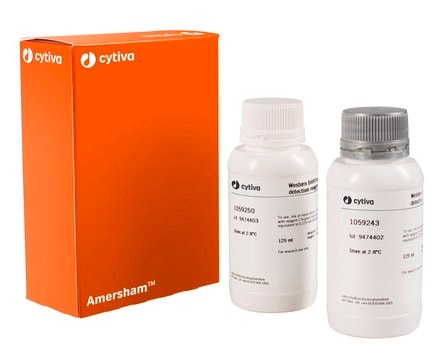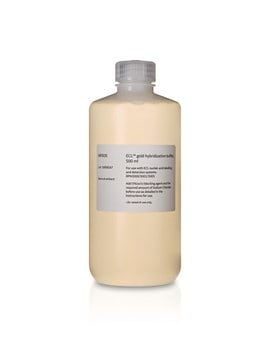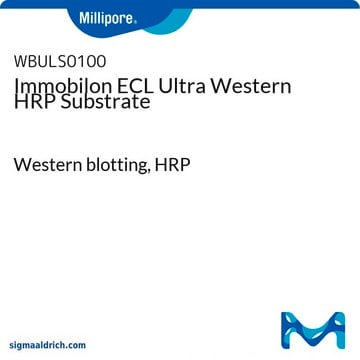GERPN2236
ECL™ Prime Western Blotting Detection Reagent
Cytiva RPN2236
Synonim(y):
chemiluminescent detection reagent, Western blotting detection reagent
About This Item
Polecane produkty
opakowanie
pkg of 1 kit
producent / nazwa handlowa
Cytiva RPN2236
Opis ogólny
Amersham ECL Prime consolidates and builds on the benefits of Amersham ECL Plus and Amersham ECL Advance to deliver a detection system that is sensitive, stable, precisely quantitative across a wide dynamic range of protein levels, and conservative in its consumption of expensive antibody reagents.
Zastosowanie
Cechy i korzyści
- Compatible with Rainbow Molecular Weight Markers and Amersham™ ECL DualVue™ Western Blotting Markers.
- High signal intensity and sensitivity allows the use of highly diluted primary and secondary antibodies with no reduction in sensitivity.
- Stable signal allows multiple exposures and makes the reagent suitable for large experimental series, allowing convenient handling time between the end of the experiment and detection.
- Optimized for use with Amersham Hybond-P® (PVDF) membranes and compatible with Amersham Hybond-ECL (nitrocellulose) membranes.
- Optimized for imaging with ImageQuant LAS series (CCD-based imaging) and compatible with Amersham Hyperfilm™.
Komponenty
- RPN2236 Solution A: Luminol solution, 3 × 50 ml Solution B: Peroxide solution, 3 × 50 ml sufficient for 3000 cm2 membrane
Przechowywanie i stabilność
Komentarz do analizy
Informacje prawne
Kod klasy składowania
12 - Non Combustible Liquids
Temperatura zapłonu (°F)
Not applicable
Temperatura zapłonu (°C)
Not applicable
Certyfikaty analizy (CoA)
Poszukaj Certyfikaty analizy (CoA), wpisując numer partii/serii produktów. Numery serii i partii można znaleźć na etykiecie produktu po słowach „seria” lub „partia”.
Masz już ten produkt?
Dokumenty związane z niedawno zakupionymi produktami zostały zamieszczone w Bibliotece dokumentów.
Klienci oglądali również te produkty
Produkty
Background and protocols describing the various methods used by molecular biologists to detect samples of protein or nucleic acids bound to membranes.
Informacje ogólne i protokoły opisujące różne metody stosowane przez biologów molekularnych do wykrywania próbek białek lub kwasów nukleinowych związanych z błonami.
This page describes troubleshooting strategies in the detection of GST-tagged proteins.
Protokoły
This page describes chemiluminescence detection of GST-tagged proteins with Amersham ECL, Amersham ECL Prime, and Amersham ECL Select from Cytiva.
This page describes how to monitor expression and purification of GST-tagged proteins by Western blot analysis using Cytiva products.
Nasz zespół naukowców ma doświadczenie we wszystkich obszarach badań, w tym w naukach przyrodniczych, materiałoznawstwie, syntezie chemicznej, chromatografii, analityce i wielu innych dziedzinach.
Skontaktuj się z zespołem ds. pomocy technicznej












